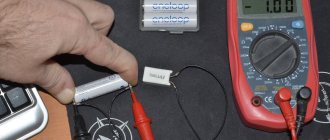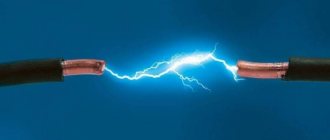Battery voltage is the main indicator of the smooth operation of all vehicle systems. In order for the vehicle's electrical equipment to work properly, its on-board battery must provide the required voltage and current values. It is important to know what values of these parameters are considered optimal in various operating modes of the battery.
Battery voltage under load
The battery voltage under load will be lower than at rest. This indicator can also be used to judge the health of the battery.
If, after connecting the load plug, the control device shows less than 9 V, then the battery is discharged and needs to be charged. If after repeating the procedure the situation does not change, the battery will need to be replaced with a new one in the near future.
If it is not possible to use a load fork to test the battery under load, then you can use a digital multimeter and turn on the engine starter as a load.
If the voltage in the on-board network drops below 9 V when the starter is turned on, then in this case you will also need to charge the battery using a charger. It is also worth checking the wiring elements and electrical consumers for serviceability.
If there is no electrical leakage in the system, and an excessive voltage drop is observed again with a fully charged battery, then the battery should be replaced.
If powerful consumers of electricity are not connected to the battery, then the voltage under light load will not change too much.
Taking indicators using special instruments
The above is theoretical information that allows you to familiarize yourself with the basic norms. However, you also need to know how to measure the voltage of your car battery. To take readings, special devices must be used that are connected directly to the battery terminals. It is recommended to check at an electrolyte temperature of 25 degrees.
When taking measurements without load, a tester is usually used. A specific operating mode is selected on it. The red contact is connected to the positive terminal, and the black one to the negative terminal. The display should show the current value.
Readings in a closed circuit allow you to fix the load fork. It simulates an engine starting situation by measuring the operating voltage under such conditions. The measuring device is connected to the outlets according to the same circuit. The battery is loaded for 5 seconds.
Battery voltage without load
The voltage of the battery, to which no electricity consumers are connected, is 12.6 - 12.8 V. If the voltage at rest is less than this indicator, this will indicate that the battery is discharged or there is a short circuit in some banks.
Operating a battery with a reduced charge level will certainly lead to the formation of lead sulfate on the plates, which will cause a significant drop in the capacity of the device.
To accurately measure the battery voltage without load, be sure to remove the terminals from the battery terminals immediately before connecting the measuring device.
Test modes
You need to check the voltage after charging in all operating modes of the car. Let's consider each of the possible options in more detail.
With the engine running
The test method with the engine running is to determine the ability of the battery to “hold” the battery charge when gradually connecting various loads. When energy consumers are turned off, the voltage of fully charged car batteries should not be less than 13.6 Volts. And after turning on the low beam, for example, this value should drop by 0.1-0.2 Volts, no more.
If you gradually connect all the equipment in the cabin, then the readings of the measuring device should decrease (as each new load is turned on). This indicates the normal condition of the battery. If the readings change sharply, the problem is most likely in the generator system, which does not provide the necessary recharging. For all loads connected to the battery, its minimum voltage should not be lower than 13.0 Volts. Otherwise, the battery will be completely discharged after some time.
Engine off
The normal voltage when the engine is off is 12.5-13.0 Volts. This value must be maintained for a day or more. If it drops over time, you will need to figure out the reasons for the leak. This could be due to high humidity or cracks in the jars. In general, there are a lot of reasons for leaks, so each specific case needs to be examined separately.
Important! Before measurements, you need to let the battery cool for about a day.
After such a time period, all chemical processes in the electrolyte caused by charging from an electric generator usually end.
At low temperatures
The peculiarity of checking battery parameters at low temperatures is that in this case the nature of chemical reactions in the electrolyte changes. Its cooling leads to a decrease in density and a voltage drop, which under these conditions is unstable and may not meet established standards.
Please note: Particular attention is paid to this phenomenon in winter. In this case, you can start checking the battery only after the density in the banks has been restored to the required value.
In regions with particularly harsh winters (down to minus 50 °C), the density will need to be increased to values from 1.27 to 1.29 g/cm3, which eliminates the possibility of the battery “freezing”. At the same time, you should always remember that in order to increase the battery life, under normal conditions they strive to reduce this indicator.
Charged battery voltage
If the battery is fully charged, the voltage will depend on the battery model. If a regular antimony battery is used, then the minimum value of this indicator should be 12.6 V.
For a calcium battery, this indicator may be slightly higher, and at the terminals of a gel battery, this parameter should not fall below 13 V. If this indicator deviates from the norm, the battery must be charged with a current equal to 10% of the battery capacity.
If the battery voltage is measured while the engine is running, the readings from the device will be significantly higher. With a working battery and relay regulator, the voltage at the terminals can reach a maximum value of 14 V.
What current should a charged battery produce?
Along with the question: what voltage should be on a charged battery, it is also important to understand the current that it can “send” to the load circuit for a long time. The value of this parameter is determined by the capacity of the lead battery; with an increase in the latter, it can operate longer at a fixed current load. So, with a capacity of 65 Ampere/hour declared by the manufacturer, for example, the battery is capable of delivering a current of 5 Ampere to the load for 13 hours.
Additional information: Different battery models may have significantly different current ratings, since they use different charge regeneration systems.
The operating values of the discharge current or amperage also depend on operating conditions (temperature and air humidity, in particular). In severe frosts and damp conditions, the battery does not perform its functions well, which is explained by a decrease in the rate of chemical reactions. To increase the value of the load current, manufacturers are developing modern technologies that make it possible to increase the efficiency of battery output through the use of more efficient materials.
Normal battery voltage
The normal battery voltage is an indicator that is displayed in the documentation for the power source. If, when purchasing a new battery, it is not possible to charge it to the value specified in the instructions, then such a malfunction will be a warranty case.
If the relay-regulator and generator on the car are working properly, then the battery will be automatically charged to a normal level during operation of the car. It is advisable to strive to use the battery throughout its entire service life only when there is normal voltage at the terminals.
With significant deviations of this parameter downward in the winter, the electrolyte in a discharged battery may completely freeze, and in the summer the lead plates will deteriorate more intensively.
| Charge level of antimony and hybrid batteries at voltage in Volts | |||||
| Electrolyte temperature | 100% | 75% | 50% | 25% | 0% |
| 48,9 | 12,663 | 12,463 | 12,253 | 12,073 | 11,903 |
| 43,3 | 12,661 | 12.,461 | 12,251 | 12,071 | 11,901 |
| 37,8 | 12,658 | 12,458 | 12,248 | 12,068 | 11,898 |
| 32,2 | 12,655 | 12,455 | 12,245 | 12,065 | 11,895 |
| 26,7 | 12,650 | 12,45 | 12,240 | 12,060 | 11,890 |
| 21,1 | 12,643 | 12,443 | 12,233 | 12,053 | 11,883 |
| 15,6 | 12,634 | 12,434 | 12,224 | 12,044 | 11,874 |
| 10 | 12,622 | 12,422 | 12,212 | 12,032 | 11,862 |
| 4,4 | 12,606 | 12,406 | 12,196 | 12,016 | 11,846 |
| -1,1 | 12,588 | 12,388 | 12,178 | 11,998 | 11,828 |
| -6,7 | 12,566 | 12,366 | 12,156 | 11,976 | 11,806 |
| -12,2 | 12,542 | 12,342 | 12,132 | 11,952 | 11,782 |
| -17,8 | 12,516 | 12,316 | 12,106 | 11,926 | 11,756 |
| Charge level for Calcium, AGM and GEL batteries at voltage in Volts | |||||
| Electrolyte temperature | 100% | 75% | 50% | 25% | 0% |
| 48,9 | 12,813 | 12,613 | 12,416 | 12,013 | 11,813 |
| 43,3 | 12,811 | 12,611 | 12,411 | 12,011 | 11,811 |
| 37,8 | 12,808 | 12,608 | 12,408 | 12,008 | 11,808 |
| 32,2 | 12,805 | 12,605 | 12,405 | 12,005 | 11,805 |
| 26,7 | 12,8 | 12,6 | 12,4 | 12,0 | 11,8 |
| 21,1 | 12,793 | 12,593 | 12,393 | 11,993 | 11,793 |
| 15,6 | 12,784 | 12,584 | 12,384 | 11,984 | 11,784 |
| 10 | 12,772 | 12,572 | 12,372 | 11,972 | 11,772 |
| 4,4 | 12,756 | 12,556 | 12,356 | 11,956 | 11,756 |
| -1,1 | 12,738 | 12,538 | 12,338 | 11,937 | 11,738 |
| -6,7 | 12,716 | 12,516 | 12,316 | 11,916 | 11,716 |
| -12,2 | 12,692 | 12,492 | 12,292 | 11,892 | 11,692 |
| -17,8 | 12,666 | 12,466 | 12,266 | 11,866 | 11,666 |
Auxiliary table
Knowing how many volts the measuring device shows, it is impossible to know the degree of wear of the electrical power source. However, it is quite possible to determine the approximate charging percentage. To do this, use the table below.
| Readings in volts | Charge percentage |
| 12,66 | 100 |
| 12,6 | 94 |
| 12,54 | 87,5 |
| 12,48 | 81 |
| 12,42 | 75 |
| 12,36 | 69 |
| 12,30 | 62,5 |
| 12,24 | 56 |
| 12,18 | 50 |
| 12,12 | 44 |
| 12,06 | 37,5 |
| 12,00 | 31 |
| 11,94 | 25 |
| 11,88 | 19 |
| 11,82 | 12,56 |
| 11,76 | 6 |
| 11,7 | 0 |
Discharged battery voltage
If the battery voltage is less than 11.6 V, then the battery is considered completely discharged. In this case, the operation of the electricity source is impossible and to restore its functionality you will need to use a charger operating from a 220 V network.
Almost all lead batteries are sensitive to full discharge. Calcium acid batteries can lose a significant part of their capacity even after a single deep discharge. The antimony device has great tolerance. Gel and AGM batteries are the most resistant to full discharge.
Main reasons for voltage drop
A car battery works on the principle of converting chemicals directly into electrical energy. When charging, the opposite happens. During operation of the device, a current is generated due to the deposition of sulfates on the plates. The electrolyte concentration decreases, and the internal resistance simultaneously increases.
Most often, the car battery voltage is lost for the following reasons:
- The battery life has completely expired;
- the generator broke down;
- there is a current leak through the wiring;
- the chain was not designed for a certain load.
The situation can be corrected in almost all cases, if we are not talking about wear and tear of the device. Normal voltage can be restored even after using the unit for several years. Current measurement alone cannot be the basis for assessing the quality characteristics of a battery.
Battery voltage in winter
In winter, constant undercharging of the battery can lead to a significant decrease in the density of the electrolyte, as a result of which the liquid inside the cans can freeze. Freezing of the electrolyte, in many cases, leads to complete inoperability of the power source. To prevent this from happening in winter, there must be at least 12.5 V at the terminals.
If a serviceable battery model is in use, the battery charge level can be monitored without using a voltmeter. It is enough to regularly measure the density of the electrolyte, which should be about 1.28 g/cm3 for a fully charged battery.
Features of battery operation
In order for the car battery voltage to remain normal for a long time, certain rules must be followed.
- Immediately before starting the engine, it is necessary to turn off electrical consumers. The load during one attempt should not exceed a time interval of 5-10 seconds. If the engine does not start after the fourth or fifth try, then the ignition and fuel supply systems should be diagnosed.
- Periodically it is necessary to check the integrity of the vehicle wiring. Existing current leaks in the circuits lead to rapid discharge of the battery, and hence loss of operating voltage. Electricity loss should be measured at service stations.
- When driving in the city in the winter, when the engine is running at low speeds and there are a lot of consumers turned on, it is advisable to recharge the battery using stationary chargers. In this case, the power supply device will last longer, producing the required current.
- The battery must be kept clean, especially in areas near the pole terminals. It is recommended to wipe it with a rag soaked in a solution of soda ash. You can also use an ammonia mixture.
Dependence of voltage on electrolyte density
The battery charge level directly depends on the density of the electrolyte. If the battery is serviceable, then the charge level can be measured quite accurately without using a tester.
Using a hydrometer, density is measured by taking a small amount of electrolyte from each jar of the device. The maximum density of the mixture of sulfuric acid and water in a fully charged battery is 1.3 g/cm3.
This indicator should be adhered to if the machine is operated in the cold. In summer, it can operate batteries with a density of 1.26 g/cm3 and higher. If the density of the electrolyte is within these limits, then the voltage at the terminals will be about 12.7 V. As the density drops, there is a proportional decrease in the potential difference at the battery terminals.
This indicator can decrease especially strongly if there are leaky places in the battery case through which some of the electrolyte will leak out. The electrolyte level can be restored by adding distilled water.
Battery charging rules
The battery must be charged in a timely manner so that the voltage during vehicle operation is optimal. When carrying out this activity, it is necessary to adhere to a number of rules.
- Charging must be done at temperatures above 0 degrees.
- Before connecting to the electrical network, the filler plugs are unscrewed and left in the mounting holes.
- You must use a device capable of providing 16 volts.
- The plugs should not be tightened for 20 minutes after charging is completed, so that accumulated gases can escape freely.
- The room must have supply and exhaust ventilation.
- The criterion for completing the charge will be the achievement of an optimal voltage or density of 1.27 g / cu. cm.
- The temperature of the electrolyte inside the device connected to the network should not exceed 45 degrees.
- It is recommended to measure current 8 hours after charging.
- If there is an indicator, then the time the device is disconnected from the network is determined by it.
How to check battery voltage with a multimeter
You can measure the operating voltage at the battery terminals using a voltmeter, which is one of the functions of a multimeter.
The battery is a source of direct current, so before starting measuring work, the device should be set to the “DC” position. You should also set the voltage limit to 20V to allow more accurate measurements.
After proper preparation of the measuring device, it will be enough to connect the black probe to the minus, and the red one to the plus of the battery, so that the device shows the DC voltage. If you mix up the probes, the value will be negative.
Still have questions about battery voltage or have something to add? Then write to us about it in the comments, this will make the material more useful, complete and accurate.
additional information
It is worth checking even the voltage of a new car battery after prolonged use. If the generator is not working well, it can gradually discharge, which means that the voltmeter readings can be much lower than normal. Recharging will be required to restore acceptable values.
It is not recommended to take measurements using an on-board PC, since the final result will have a significant error, which is explained by the specifics of connecting the device to the network. Estimates should not be used to identify problems.
A comprehensive battery check must be carried out regularly. If the vehicle has not been driven for several days and the meter shows a significant drop in voltage, the power supply has reached the end of its service life.
How to correctly measure the voltage on the battery and in the vehicle’s on-board network
Let us repeat that the battery voltage is an indicator of its operating condition. There are several ways to measure it:
- using a multimeter or voltmeter;
- using a load fork;
- measuring the density of the electrolyte.
Next, we will consider each of the listed options in more detail.
Multimeter or voltmeter
To measure the voltage on the battery, many use a simple and very long-used, and therefore proven, method - using a multimeter. This device allows you to make measurements with an accuracy of tenths and even hundredths of a volt.
Important! To obtain reliable results, it is necessary that 4-5 hours have passed since the last charge or discharge. During this time, the voltage stabilizes.
To measure, switch the multimeter to constant voltage measurement mode and the measurement limit closest to 12 V, usually 20 volts, designated “20 DCV”.
If there is a need to more accurately measure the battery charge level, you will have to use special chargers that have memory and a microprocessor. With their help, it is possible to track and compare not only the discharge process, but also the normal charging of the battery over a certain number of cycles.
Checking and measuring with a load fork
The essence of this method of checking the normal battery voltage is extremely simple - measurements are made under load, which allows you to accurately assess the condition of the battery.
To make it clear, let's look at an example. If a battery with a capacity of 60 Ah is checked, then the minimum load should be 120 A. It is applied for 3-5 seconds. More information on using the load fork can be found here: .
Electrolyte density measurement
For vehicles that have serviceable batteries with liquid electrolyte, the state of charge can be determined by measuring its density. The relationship between these parameters is clearly shown in the table below.
| Charge level (%) | Electrolyte density (g/cm3) |
| 100 | 1.266 |
| 95 | 1.258 |
| 90 | 1.250 |
| 85 | 1.242 |
| 80 | 1.234 |
| 78 | 1.226 |
| 70 | 1.219 |
| 65 | 1.212 |
| 60 | 1.205 |
| 55 | 1.198 |
| 50 | 1.191 |
| 40 | 1.177 |
| 30 | 1.163 |
| 20 | 1.149 |
| 10 | 1.135 |
To be fair, it should be noted that the information contained in the table is valid for batteries used in the middle zone. Depending on climatic conditions, the normal density varies:
- 1.27-1.29 g/cm3 - for cold regions, and at any time of the year;
- 1.25-1.27 g/cm3 - as we have already said, for the middle band;
- 1.23-1.25 g/cm3 - places with high average annual air temperatures.
For your information! Density checks are carried out once every 3 months. Even minor deviations from the norm are unacceptable.
What to do if the battery charge is not normal?
The answer to this question is simple. If the battery charge is not normal, the battery needs to be charged. The charging process was described in detail in the article “How to properly charge a car battery with a charger.” Here I would like to note some nuances.
Charger
There are three main types of charging:
- accelerated This mode is often called Boost and can be found on many modern chargers (chargers). In this mode, the battery charge is not fully charged, but it is quite enough to start the engine. This type of charging is used when you need to go urgently and the battery is low. This mode is not recommended to be used continuously. Here, the charge is accelerated by increasing the current strength, which increases the battery life;
- with constant voltage. This type of charging involves maintaining a constant voltage across the terminals. This mode is used in the automatic charge mode on most chargers. It is recommended to use it when the battery is not very discharged (not lower than 12 volts). Read more about car battery voltage in the article at the link. The advantage of this mode is that you don't have to control it. The charger itself will determine when the charge is normal and stop the process;
- with direct current. This charging option involves supplying constant current to the battery. The process is carried out in several stages, in which the current gradually decreases. This mode is recommended when charging a deeply discharged battery. It allows you to charge the battery most fully and evenly. The downside is that you will have to constantly monitor the process, measure the voltage and stop the process when the battery charge is normal.
Battery charging process
In conclusion, I would like to remind you about the safety rules when charging a battery. The process must be carried out in a ventilated area. It is better not to charge in residential areas. There should be no open flames or sparks near the battery being charged. During the charging process, hydrogen is released, which in combination with oxygen forms an explosive mixture!
We also recommend reading the material about how much a car battery weighs.











